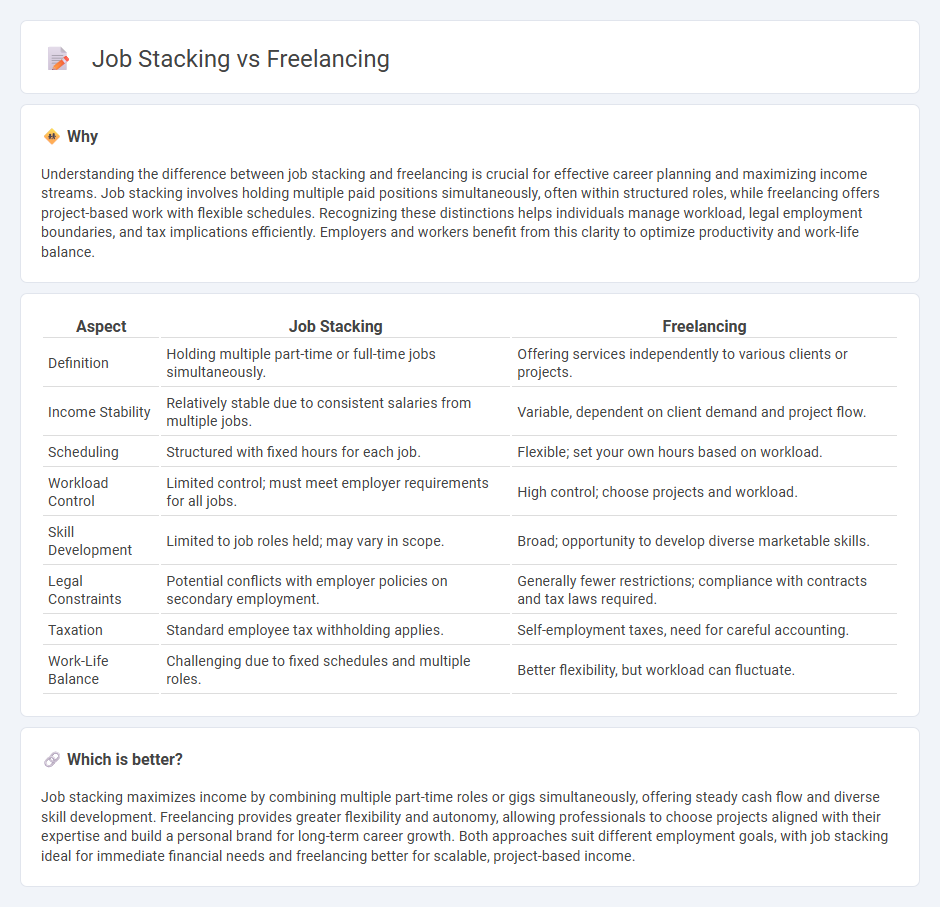
Job stacking involves holding multiple part-time or full-time jobs simultaneously to maximize income and diversify work experience, while freelancing offers project-based work with flexible schedules and varied client engagements. Both approaches provide alternative income streams, but job stacking requires managing fixed work hours across roles, whereas freelancing demands self-motivation to secure projects and meet deadlines. Explore deeper insights into job stacking and freelancing strategies to optimize your career growth.
Why it is important
Understanding the difference between job stacking and freelancing is crucial for effective career planning and maximizing income streams. Job stacking involves holding multiple paid positions simultaneously, often within structured roles, while freelancing offers project-based work with flexible schedules. Recognizing these distinctions helps individuals manage workload, legal employment boundaries, and tax implications efficiently. Employers and workers benefit from this clarity to optimize productivity and work-life balance.
Comparison Table
| Aspect | Job Stacking | Freelancing |
|---|---|---|
| Definition | Holding multiple part-time or full-time jobs simultaneously. | Offering services independently to various clients or projects. |
| Income Stability | Relatively stable due to consistent salaries from multiple jobs. | Variable, dependent on client demand and project flow. |
| Scheduling | Structured with fixed hours for each job. | Flexible; set your own hours based on workload. |
| Workload Control | Limited control; must meet employer requirements for all jobs. | High control; choose projects and workload. |
| Skill Development | Limited to job roles held; may vary in scope. | Broad; opportunity to develop diverse marketable skills. |
| Legal Constraints | Potential conflicts with employer policies on secondary employment. | Generally fewer restrictions; compliance with contracts and tax laws required. |
| Taxation | Standard employee tax withholding applies. | Self-employment taxes, need for careful accounting. |
| Work-Life Balance | Challenging due to fixed schedules and multiple roles. | Better flexibility, but workload can fluctuate. |
Which is better?
Job stacking maximizes income by combining multiple part-time roles or gigs simultaneously, offering steady cash flow and diverse skill development. Freelancing provides greater flexibility and autonomy, allowing professionals to choose projects aligned with their expertise and build a personal brand for long-term career growth. Both approaches suit different employment goals, with job stacking ideal for immediate financial needs and freelancing better for scalable, project-based income.
Connection
Job stacking and freelancing are interconnected through their emphasis on multiple income streams and flexible work arrangements. Freelancing typically involves offering specialized services to various clients, enabling professionals to diversify their skill sets and income sources. Job stacking leverages this model by combining several freelance gigs or part-time roles, maximizing earning potential without committing to a single full-time position.
Key Terms
Flexibility
Freelancing offers unparalleled flexibility by allowing professionals to choose projects, set their own hours, and work from any location, adapting their workload to personal preferences. Job stacking involves holding multiple part-time jobs simultaneously, providing income diversification but often with fixed schedules and less control over timing. Discover more insights on balancing freedom and stability between freelancing and job stacking strategies.
Income streams
Freelancing offers diverse income streams by allowing professionals to take on multiple clients and projects simultaneously, resulting in flexible and scalable earnings. Job stacking combines part-time jobs or gigs to maximize steady income flow, balancing risk through varied employment sources. Explore strategies to optimize your financial growth through freelancing versus job stacking.
Autonomy
Freelancing offers greater autonomy by allowing individuals to choose clients, set schedules, and control project selection, fostering a personalized work environment. Job stacking involves managing multiple part-time jobs simultaneously, which can limit flexibility but may provide diverse income streams and skill development. Explore the benefits and challenges of each approach to determine which best supports your professional independence.
Source and External Links
Freelancing 101: What is Freelancing? - Freelancing is a form of self-employment that gives you the freedom to work for multiple clients, manage your own schedule, and live anywhere with an internet connection, offering services based on your skills and experience.
What Is Freelancing? Basics and Popular Jobs in 2025 - Freelancing involves working for clients without full-time employment commitment; key steps to start include picking a niche, building a portfolio, setting rates, creating a professional presence, and managing projects effectively.
25 best freelance websites to find work in 2025 - Freelancing offers flexible work arrangements, allowing professionals to choose projects and clients, set rates, and gain faster professional growth, with many platforms available to find freelance opportunities, ideal also for beginners.
 dowidth.com
dowidth.com